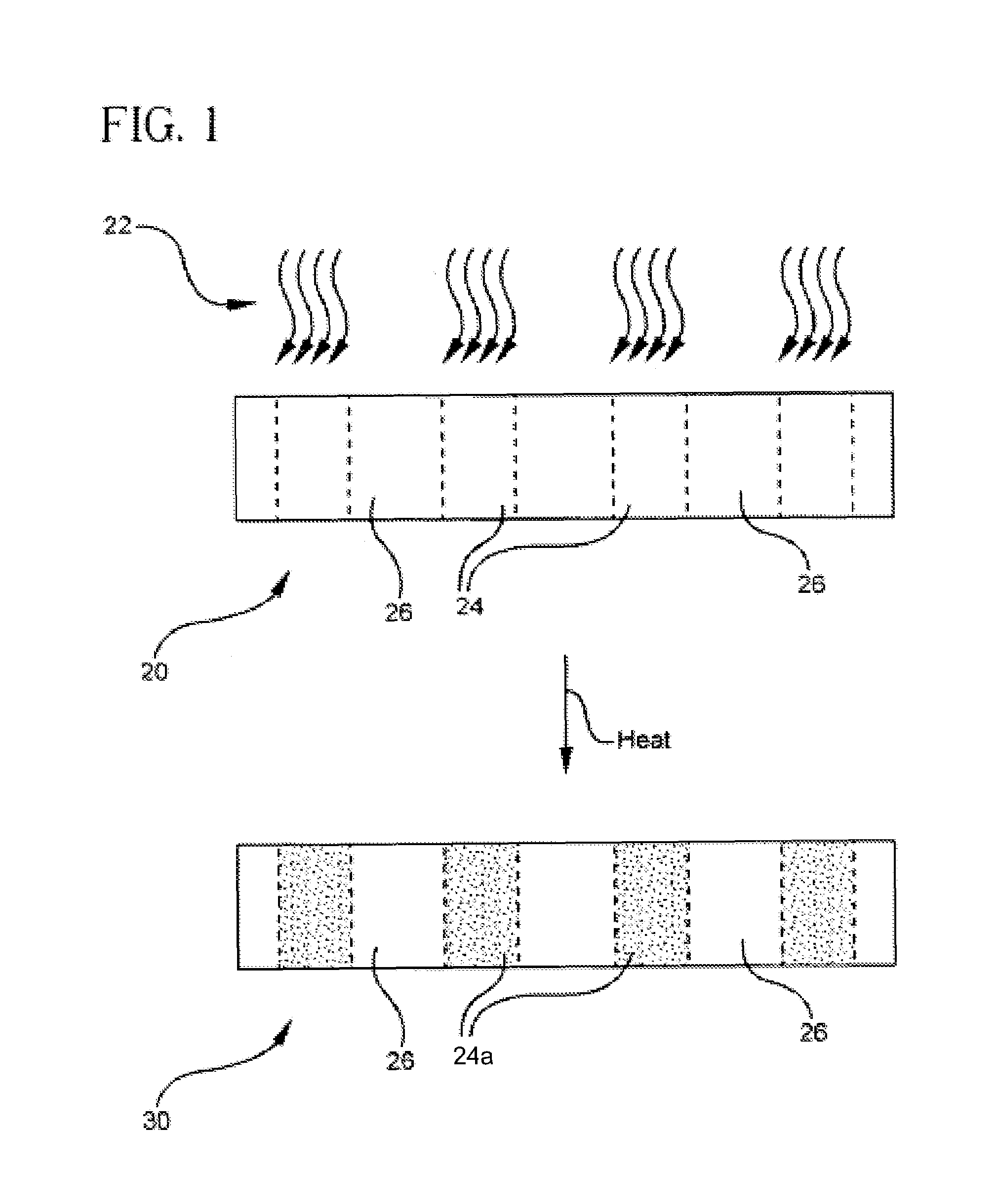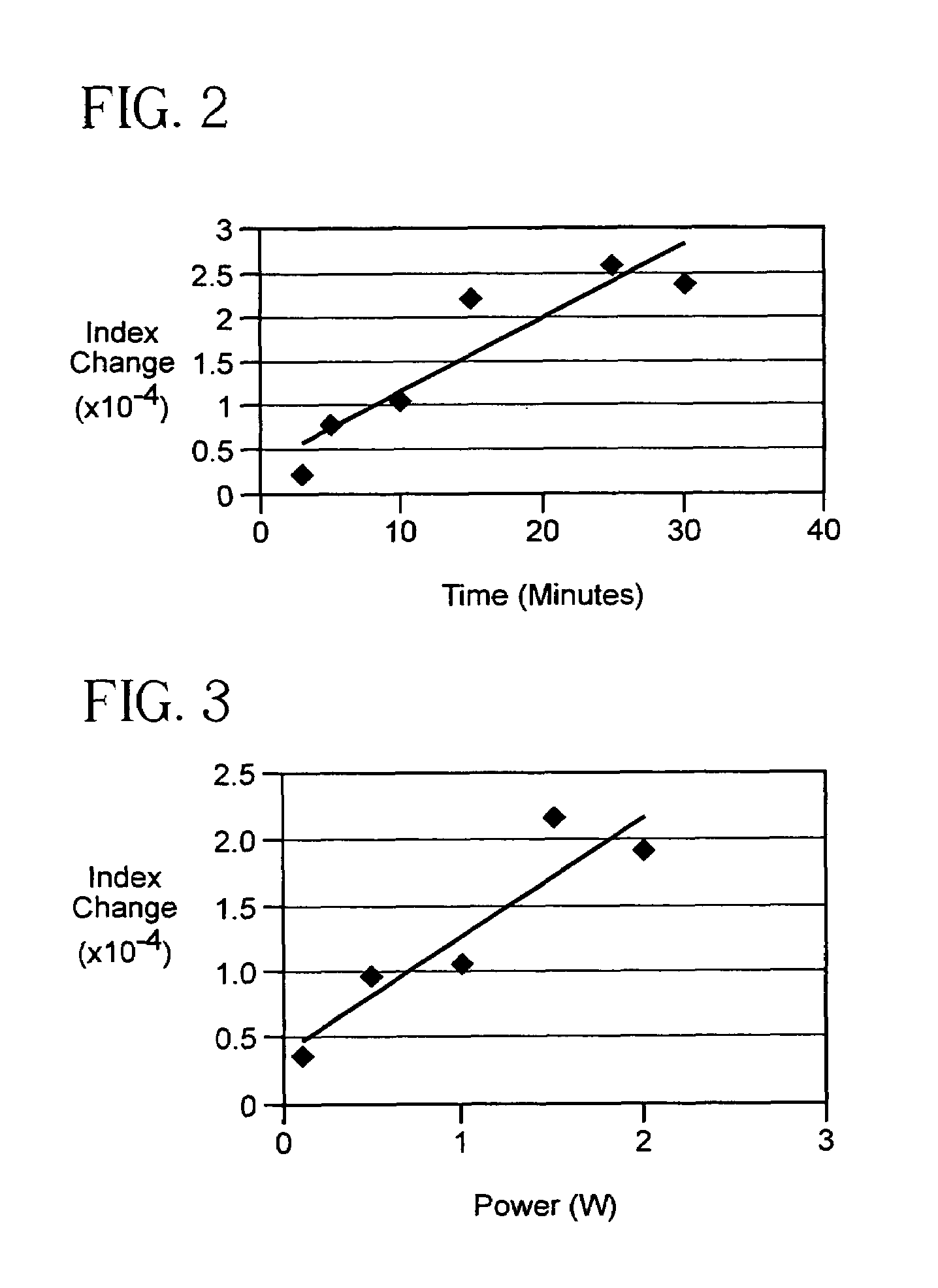Photorefractive glass and optical elements made therefrom
a technology of photorefractive glass and optical elements, applied in the field of photorefractive glasses, can solve the problems of narrow-band filtering performance, inconvenient manufacturing, and inability to meet the requirements of many optical systems, and achieve the effect of high photoinduced refractive index changes and simplified manufacturing
- Summary
- Abstract
- Description
- Claims
- Application Information
AI Technical Summary
Benefits of technology
Problems solved by technology
Method used
Image
Examples
examples
[0040]The present invention is further described by the following non-limiting examples.
Example A-D
Glass Formation
[0041]The photosensitive glass materials for Example A-D listed in Table 2 were melted using methods familiar to the skilled artisan. Iota sand, boric acid, sodium chloride, sodium nitrate, sodium silicofluoride, antimony trioxide, zinc oxide and alumina were used as batch materials. The batched mixture was ball milled for 60 minutes, melted in platinum crucibles at temperatures of about 1425° C. for four hours, cast into slabs 4 inches wide and 1 inch thick, and annealed at 650° C. Concentrations are given in wt % on an as-batched basis.
[0042]
TABLE 2ABCDSiO269.3469.3169.2468.94Al2O36.656.646.646.60Na2O15.6015.5915.5815.51ZnO4.824.814.814.79Sb2O30.020.020.020.02SnO0.050.050.050.01Ag0.010.010.010.01F2.412.412.402.87Br1.061.061.061.05GeO200.10.20.19CeO20.05000
example a-d
Exposure Conditions
[0043]The so-formed glass material of Examples A-E was formed into 1-mm thick slides as described above. A portion of each slide was exposed to 248 nm radiation from a KrF excimer laser for times ranging from 6-20 minutes at 10 Hz. The fluence per pulse ranged between about 30-60 mJ / cm2. The slides were then heat treated in a furnace at 480-520° C. for approximately 2 hours, and allowed to cool to room temperature resulting in the formation of Bragg gratings.
[0044]The Bragg gratings so formed in the glass slides were illuminated from the edge of the slide with collimated 633 nm radiation. The diffraction efficiency was used to determine the index contrast between the exposed regions and unexposed regions of the Bragg gratings using the equation
[0045]efficiency=sin2(2πΔnLλ)
where λ is the wavelength of the illuminating light, L is the thickness of the grating, and Δn is the index contrast between the exposed and unexposed regions of the grating. It follows that ...
example e
[0051]Glass material of the composition of Example E was actually formed into 6 slabs of the 4 inches wide and 1 inch thick dimension disclosed above. The 6 slabs were irradiated through a chrome absorption mask having a 10 μm grating pitch with the output of 355 nm radiation at average power of approximately 12 W at 10 Hz; the exposure times varied for the five samples from 3 to 30 minutes as detailed in Table 6. After irradiation, the samples were heat treated in a furnace at 550° C. for 2 hours to complete the formation of the Bragg gratings.
[0052]As above, the 6 Bragg gratings so formed in the glass slides were illuminated from the edge of the slide with collimated 633 nm radiation. The diffraction efficiency was again used to determine the index contrast between the exposed regions and unexposed regions of the Bragg gratings. The refractive index contrast (nexposed−nunexposed) data for various exposure times are given in Table 6 and plotted in FIG. 2. Like the samples A...
PUM
| Property | Measurement | Unit |
|---|---|---|
| wavelengths | aaaaa | aaaaa |
| wavelengths | aaaaa | aaaaa |
| wavelengths | aaaaa | aaaaa |
Abstract
Description
Claims
Application Information
 Login to View More
Login to View More - R&D
- Intellectual Property
- Life Sciences
- Materials
- Tech Scout
- Unparalleled Data Quality
- Higher Quality Content
- 60% Fewer Hallucinations
Browse by: Latest US Patents, China's latest patents, Technical Efficacy Thesaurus, Application Domain, Technology Topic, Popular Technical Reports.
© 2025 PatSnap. All rights reserved.Legal|Privacy policy|Modern Slavery Act Transparency Statement|Sitemap|About US| Contact US: help@patsnap.com



